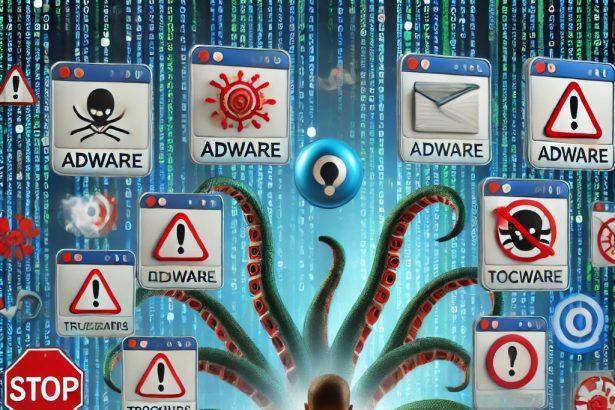Controllednetworkpc.com is a deceptive website that tricks users into subscribing to intrusive browser notifications by displaying fake CAPTCHA verification prompts. Once permission is granted, users are bombarded with misleading pop-ups, fake alerts, and redirects to potentially harmful websites. This behavior classifies it as both a browser hijacker and an adware threat.
Threat Overview
Controllednetworkpc.com uses social engineering tactics to manipulate users into clicking the “Allow” button under the guise of verifying they are not a robot. Once enabled, it delivers an onslaught of unwanted notifications that may include phishing content, scam promotions, or links to malware-laden sites. This not only threatens user privacy but also degrades overall system performance.
Threat Summary
| Attribute | Details |
|---|---|
| Threat Type | Browser Hijacker, Adware |
| Associated Domain | controllednetworkpc.com |
| Detection Names | Fortinet (Phishing), VirusTotal (various) |
| Symptoms of Infection | Unwanted pop-up ads, browser redirects, sluggish browser performance, changes to browser settings without user consent |
| Damage | Privacy invasion, potential malware exposure, deceptive ads, reduced system performance |
| Distribution Methods | Fake CAPTCHA prompts, deceptive pop-ups, adware-bundled software |
| Danger Level | Moderate |
| Removal Tool | SpyHunter |
In-Depth Analysis
How Did I Get Infected?
Users typically encounter Controllednetworkpc.com through:
- Clicking deceptive pop-ups or fake CAPTCHA verification screens.
- Visiting compromised or low-quality websites containing redirect scripts.
- Downloading software bundled with hidden adware components.
Once a user clicks “Allow” on the prompt, the site is granted permission to send notifications directly to the browser, leading to persistent advertisements and frequent redirects to shady domains.
What Does It Do?
After receiving permission to send notifications, Controllednetworkpc.com begins:
- Sending intrusive advertisements that appear on the desktop or browser.
- Redirecting users to phishing pages or scam websites.
- Promoting fake software updates, adult content, or tech support scams.
- Collecting browsing data for monetization or malicious intent.
- Degrading browsing performance and consuming system resources.
Should You Be Worried?
Yes. While it may initially appear as a harmless nuisance, Controllednetworkpc.com poses the following risks:
- Privacy Breach: May track browsing activity and harvest personal information.
- Security Concerns: Exposure to malware and phishing scams.
- System Slowdowns: Constant pop-ups and redirects reduce usability and performance.
Immediate action is recommended to block the domain and remove any associated adware or hijacker components.
Manual Removal Guide for Browser Hijackers
Step 1: Uninstall Suspicious Programs (Windows & Mac)
Before resetting your browser, remove any software that may have installed the hijacker.
Windows (10, 11, 8, 7)
- Press
Win + R, typeappwiz.cpl, and hit Enter. - Find Unwanted Applications
- Look for recently installed programs that seem suspicious (e.g., “EasySearch,” “QuickFind,” “Search Manager”).
- Uninstall
- Click on the suspicious program > Select Uninstall > Follow on-screen instructions.
Mac (macOS Ventura, Monterey, Big Sur, Catalina, Mojave, etc.)
- Open Finder and go to Applications.
- Look for unknown or unwanted programs.
- Drag any suspicious apps to the Trash and empty the Trash.
Step 2: Remove Browser Hijacker from Web Browsers
Google Chrome
- Reset Chrome to Default Settings
- Open Chrome > Click ⋮ Menu (top-right corner) > Settings.
- Scroll down and select Reset settings > Click Restore settings to original defaults > Confirm.
- Remove Suspicious Extensions
- Open chrome://extensions/ and remove unknown extensions.
- Change Default Search Engine & Homepage
- Go to Settings > Search engine > Select Google or another trusted search engine.
- Under On Startup, remove any unwanted URLs.
Mozilla Firefox
- Reset Firefox
- Click the Menu (☰) > Select Help > Click More Troubleshooting Information > Refresh Firefox.
- Remove Unknown Extensions
- Open Add-ons Manager (
Ctrl + Shift + A) > Remove any suspicious extensions.
- Open Add-ons Manager (
- Change Search Engine & Homepage
- Open Settings > Search > Choose Google or another safe search engine.
Microsoft Edge
- Reset Edge
- Click ⋮ Menu > Settings > Reset settings > Restore to default values.
- Remove Unwanted Extensions
- Open edge://extensions/ and remove any unfamiliar extensions.
Safari (Mac Only)
- Reset Safari & Clear Data
- Open Safari > Click Safari (top-left menu) > Select Clear History.
- Go to Preferences > Privacy > Click Manage Website Data > Remove All.
- Delete Suspicious Extensions
- Open Safari > Preferences > Extensions > Remove anything unfamiliar.
- Change Homepage & Search Engine
- Open Preferences > General > Change your homepage to a trusted site.
- In Search, set your search engine to Google or a preferred option.
Step 3: Check for Unauthorized System Changes
Windows – Check the Hosts File
- Open Notepad as Administrator (
Win + S, type Notepad, right-click, Run as Administrator). - Click File > Open and navigate to:makefileCopyEdit
C:\Windows\System32\drivers\etc\hosts - If you see unknown IPs or URLs at the bottom, remove them.
- Save changes and restart your computer.
Mac – Check the Hosts File
- Open Terminal (
Command + Space, typeTerminal). - Type:bashCopyEdit
sudo nano /etc/hosts - Look for suspicious entries and delete them.
- Press
Ctrl + X, thenY, thenEnterto save.
Automatic Removal Using SpyHunter (Windows & Mac)
For those who prefer a quick, hassle-free removal process, using SpyHunter is highly recommended.
Step 1: Download SpyHunter
Click here to download SpyHunter: Download SpyHunter
Step 2: Install & Run SpyHunter
- Follow the instructions on the SpyHunter Download Page to install the software.
- Open SpyHunter and run a full system scan.
Step 3: Remove Browser Hijackers
- SpyHunter will detect all malware and potentially unwanted programs.
- Click Fix Threats to remove the detected hijacker.
- Restart your device to complete the cleanup process.
Step 4: Reset Browser Settings (If Necessary)
Even after SpyHunter removes the hijacker, you may need to reset your browser settings manually (refer to browser-specific instructions above).
Preventing Future Browser Hijacker Infections
- Be cautious when installing free software – opt for Custom Installation to avoid bundled malware.
- Avoid clicking on suspicious ads or pop-ups – they often distribute browser hijackers.
- Keep your operating system and software updated – outdated programs are more vulnerable to infections.
- Use a trusted anti-malware tool like SpyHunter to provide real-time protection against threats.
Conclusion
Controllednetworkpc.com is a rogue website that uses social engineering to flood users with misleading browser notifications. These deceptive pop-ups can lead to more dangerous malware infections, compromise your privacy, and severely hinder your browsing experience. To fully remove this threat and prevent future infections, use a professional malware removal tool like SpyHunter.




